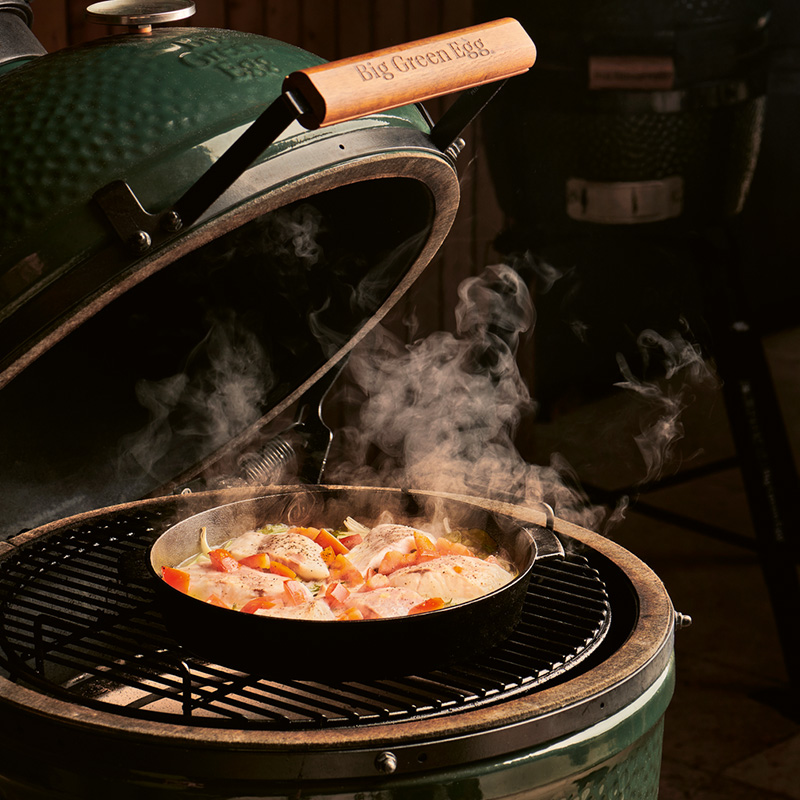Steaming
Want to steam food? Surely you need a special steam oven, steamer or a steamer basket for that? Not if you have a Big Green Egg, because steaming is one of the many cooking techniques possible with this kamado. But what makes a Big Green Egg so suitable for steaming and how do you actually do it?
Steaming in a Big Green Egg is easier than you might think and it has several advantages over steaming in a steam oven or a steamer. For starters, you need to clean a steam oven more often than a conventional oven and, when steaming in a pan, you either need a special pan, or an extra steamer basket. When steaming in the Big Green Egg, none of this applies. But the biggest advantage of steaming food in the EGG is the delicious flavour imparted to your ingredients.

Cooking with steam
Steaming food simply means cooking at high humidity in a hot environment. Thanks to the EGG’s lid and ceramics, the humidity in this kamado is already high, keeping ingredients deliciously tender and juicy. Steam them in your Big Green Egg and you create an even higher humidity with an even juicier result. The easiest thing might seem to be to put a bowl of boiling water or some other liquid on the heat shield under the grill, but leave that to others. In fact, there is a much easier way to cook with steam with much better and tastier results.
Direct or indirect method
Steaming in your Big Green Egg is a direct or indirect preparation for which, in addition to your ingredients, all you need is the included stainless steel grid and a cast iron skillet or a Dutch oven. During the process, you make use of the airflow within your kamado and the reflection of heat by the ceramic and, with the direct method, the glow of the charcoal (radiant heat). There is no direct contact heat with the ingredient you are steaming, which means it will cook slowly, despite the high starting temperature.

At what temperature should you steam food?
When steaming, you should maintain an initial temperature of around 220°C. While the Big Green Egg is heating up, cut firm vegetables, such as root vegetables, tuber vegetables or cabbage into equal strips, so that they are cooked at the same time. Or you could use marsh samphire, for example, to serve with fish. Has the kamado reached the right temperature? Then place the skillet containing the evenly distributed vegetables on the grill, with the heat shield underneath if necessary.
How do you create steam to cook food?
To create steam to cook the ingredient, pour a layer of about 1 centimetre of cold liquid of your choice into the skillet and place your base ingredient on top of the vegetables. Just make sure the main ingredient is not touching the liquid. If the liquid does touch the ingredient, you will be poaching it rather than steaming it. Finally, close the lid of the Big Green Egg and slightly open the air regulator and rEGGulator. The extra oxygen supply makes the charcoal glow more brightly, causing the liquid in the skillet to heat up quickly. After about 6 minutes, this will have reached a temperature of 80°C, after which steam will start to be created. Eventually, the moisture required for steaming will reach a temperature of 100°C. While cooking with this method, open the lid of the EGG as little as possible, to prevent steam from escaping.
-
Which ingredients can you steam?
You can cook an infinite number of ingredients with steam. Examples include vegetables such as broccoli, carrots and asparagus, fish such as salmon and cod, shellfish including mussels and oysters, and meat and poultry such as chicken fillet and lean beef strips. Meat containing a lot of fat and/or connective tissue is not suitable for steaming. Simply start experimenting!
-
What are the cooking times per ingredient when steaming?
The cooking time of your ingredient depends on the product you are steaming. A piece of fish fillet will be cooked after about 10 to 15 minutes, while a chicken fillet will need at least 25 minutes,because the exact cooking time depends on several factors, such as the initial temperature in your EGG, the temperature in your kamado, the amount of moisture and the time it takes for steam to form. To make sure your ingredient is cooked in the case of meat, fish and poultry, use a core thermometer if necessary. In the case of vegetables, feel whether they are cooked and in the case of shellfish like mussels, check whether the shells are open properly. Are you steaming an ingredient where you can’t check this? Then judge the doneness by eye.
-
What liquid can you use to steam food for extra flavour?
Which liquid should you use? That’s entirely up to you. Water is always possible, but – depending on your base ingredient – it is also nice’, for example, to add white wine, fish or poultry stock, or even a dash of whisky. One thing is certain: the result will be tender, juicy and moreish! While steaming, the ingredients absorb each other’s flavours and that of the charcoal. So, not only is it delicious to serve your main ingredient and vegetables – the liquid is also packed with flavour.







